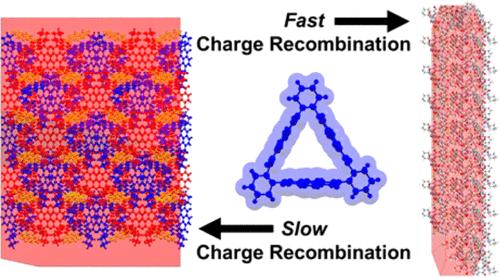由芳香族供体和手性三(萘二亚胺)三角受体组成的超分子网状结构中的电荷转移动力学
IF 14.4
1区 化学
Q1 CHEMISTRY, MULTIDISCIPLINARY
引用次数: 0
摘要
了解供体-受体(D-A)共晶体中的电荷转移(CT)动力学对于开发高效的有机光伏和电子材料非常重要。本研究探讨了手性三(萘二亚胺)三角棱柱(-)-NDI-Δ与芘、苝和苝电子供体共晶体形成的超分子方格的光生 CT 状态。通过调节结晶条件,实现了具有不同结构图案和形态的一维(1D)和二维(2D)共晶体。我们采用飞秒和纳秒瞬态吸收显微镜以及时间分辨电子顺磁共振光谱来阐明 CT 态的动力学。我们的研究结果表明,相对于一维共晶体,二维共晶体的 CT 状态寿命更长,这归因于它们之间的对称性和分子堆积差异调节了 CT 的相互作用。这项工作凸显了在共晶体中使用预组织共价多位点电荷载流子作为供体或受体的潜力,是一种具有可调 CT 特性的先进多功能材料工程结构的策略。本文章由计算机程序翻译,如有差异,请以英文原文为准。

Charge Transfer Dynamics in Supramolecular Tessellations Composed of Aromatic Donors and Chiral Tris(naphthalenediimide) Triangular Acceptors
Understanding charge transfer (CT) dynamics in donor–acceptor (D–A) cocrystals is important for the development of efficient organic photovoltaic and electronic materials. This study explores the photogenerated CT states of supramolecular tessellations formed by cocrystallizing a chiral tris(naphthalenediimide) triangular prism (−)-NDI-Δ with pyrene, perylene, and peri-xanthenoxanthene electron donors. By manipulating crystallization conditions, one-dimensional (1D) and two-dimensional (2D) cocrystals with distinct structural motifs and morphologies are achieved. Femtosecond and nanosecond transient absorption microscopies and time-resolved electron paramagnetic resonance spectroscopy were employed to elucidate the CT state dynamics. Our findings reveal that the CT state lifetimes are lengthened in the 2D cocrystals relative to the 1D cocrystals, which is attributable to the symmetry and molecular packing differences between them that modulate the CT interactions. This work highlights the potential of using preorganized covalent multisite charge carriers as donors or acceptors in cocrystals as a strategy for engineering structures for advanced multifunctional materials with tunable CT properties.
求助全文
通过发布文献求助,成功后即可免费获取论文全文。
去求助
来源期刊
CiteScore
24.40
自引率
6.00%
发文量
2398
审稿时长
1.6 months
期刊介绍:
The flagship journal of the American Chemical Society, known as the Journal of the American Chemical Society (JACS), has been a prestigious publication since its establishment in 1879. It holds a preeminent position in the field of chemistry and related interdisciplinary sciences. JACS is committed to disseminating cutting-edge research papers, covering a wide range of topics, and encompasses approximately 19,000 pages of Articles, Communications, and Perspectives annually. With a weekly publication frequency, JACS plays a vital role in advancing the field of chemistry by providing essential research.

 求助内容:
求助内容: 应助结果提醒方式:
应助结果提醒方式:


